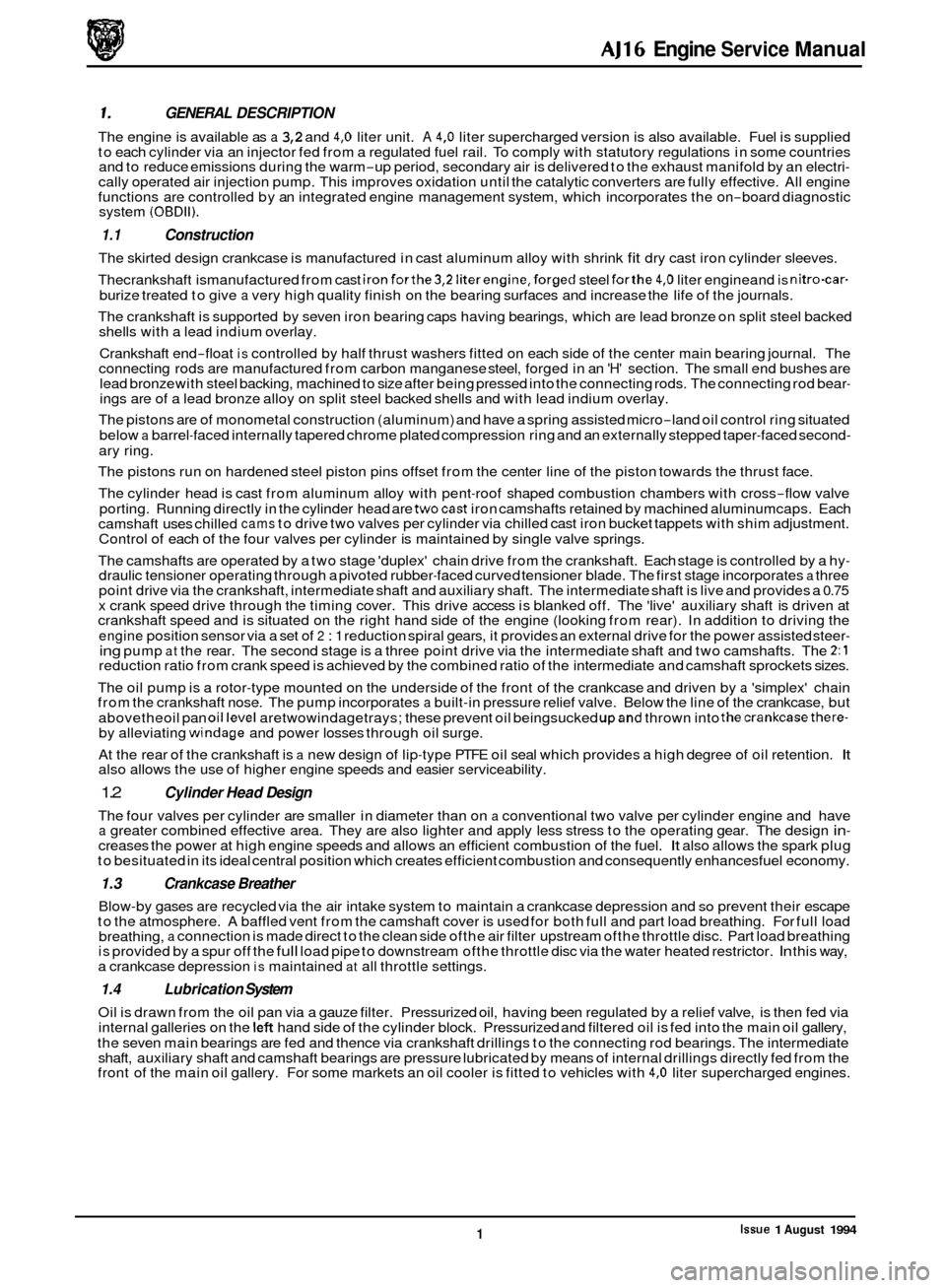tow bar JAGUAR XJ 1994 2.G AJ16 Engine Manual
[x] Cancel search | Manufacturer: JAGUAR, Model Year: 1994, Model line: XJ, Model: JAGUAR XJ 1994 2.GPages: 73, PDF Size: 2.06 MB
Page 20 of 73

AJ16 Engine Service Manual
0 GENERAL DESCRIPTION - The engine is available as a 3,2 and 4,O liter unit. A 4,O liter supercharged version is also available. Fuel is supplied
to each cylinder via an injector fed from a regulated fuel rail. To comply with statutory regulations in some countries
and to reduce emissions during the warm
-up period, secondary air is delivered to the exhaust manifold by an electri- cally operated air injection pump. This improves oxidation until the catalytic converters are fully effective. All engine
functions are controlled by an integrated engine management system, which incorporates the on-board diagnostic
system (OBDII).
1.1 Construction
The skirted design crankcase is manufactured in cast aluminum alloy with shrink fit dry cast iron cylinder sleeves.
Thecrankshaft ismanufactured from cast
ironforthe3,2 literengine,forged steel forthe 4,O liter engineand is nitro-car-
burize treated to give a very high quality finish on the bearing surfaces and increase the life of the journals.
The crankshaft is supported by seven iron bearing caps having bearings, which are lead bronze on split steel backed
shells with a lead indium overlay.
Crankshaft end
-float is controlled by half thrust washers fitted on each side of the center main bearing journal. The
connecting rods are manufactured from carbon manganese steel, forged in an 'H' section. The small end bushes are
lead bronze with steel backing, machined to size after being pressed into the connecting rods. The connecting rod bear- ings are of a lead bronze alloy on split steel backed shells and with lead indium overlay.
The pistons are of monometal construction (aluminum) and have a spring assisted micro
-land oil control ring situated
below a barrel-faced internally tapered chrome plated compression ring and an externally stepped taper-faced second-
ary ring.
The cylinder head is cast from aluminum alloy with pent
-roof shaped combustion chambers with cross-flow valve
porting. Running directly in the cylinder head are
twocast iron camshafts retained by machined aluminumcaps. Each
camshaft uses chilled cams to drive two valves per cylinder via chilled cast iron bucket tappets with shim adjustment.
Control of each of the four valves per cylinder is maintained by single valve springs.
The camshafts are operated by a two stage 'duplex' chain drive from the crankshaft. Each stage is controlled by a hy
- draulic tensioner operating through a pivoted rubber-faced curved tensioner blade. The first stage incorporates a three
point drive via the crankshaft, intermediate shaft and auxiliary shaft. The intermediate shaft is live and provides a 0.75 x crank speed drive through the timing cover. This drive access is blanked off. The 'live' auxiliary shaft is driven at
crankshaft speed and is situated on the right hand side of the engine (looking from rear). In addition to driving the
engine position sensor via a set of 2 : 1 reduction spiral gears, it provides an external drive for the power assisted steer- ing pump at the rear. The second stage is a three point drive via the intermediate shaft and two camshafts. The 2:l reduction ratio from crank speed is achieved by the combined ratio of the intermediate and camshaft sprockets sizes.
The oil pump is a rotor
-type mounted on the underside of the front of the crankcase and driven by a 'simplex' chain
from the crankshaft nose. The pump incorporates a built-in pressure relief valve. Below the line of the crankcase, but
abovetheoil pan
oillevel aretwowindagetrays; these prevent oil beingsucked upand thrown into thecrankcasethere- by alleviating windage and power losses through oil surge.
At the rear of the crankshaft is
a new design of lip-type PTFE oil seal which provides a high degree of oil retention. It also allows the use of higher engine speeds and easier serviceability.
1.2 Cylinder Head Design
The four valves per cylinder are smaller in diameter than on a conventional two valve per cylinder engine and have a greater combined effective area. They are also lighter and apply less stress to the operating gear. The design in- creases the power at high engine speeds and allows an efficient combustion of the fuel. It also allows the spark plug
to besituated in its ideal central position which creates efficient combustion and consequently enhancesfuel economy.
1.3 Crankcase Breather
Blow-by gases are recycled via the air intake system to maintain a crankcase depression and so prevent their escape
to the atmosphere. A baffled vent from the camshaft cover is used for both full and part load breathing. For full load
breathing,
a connection is made direct to the clean side ofthe air filter upstream ofthe throttle disc. Part load breathing is provided by a spur off the full load pipe to downstream ofthe throttle disc via the water heated restrictor. In this way,
a crankcase depression is maintained at all throttle settings.
1.4 Lubrication System
Oil is drawn from the oil pan via a gauze filter. Pressurized oil, having been regulated by a relief valve, is then fed via
internal galleries on the left hand side of the cylinder block. Pressurized and filtered oil is fed into the main oil gallery,
the seven main bearings are fed and thence via crankshaft drillings to the connecting rod bearings. The intermediate
shaft, auxiliary shaft and camshaft bearings are pressure lubricated by means of internal drillings directly fed from the
front of the main oil gallery. For some markets an oil cooler is fitted to vehicles with
4,O liter supercharged engines.
The pistons run on hardened steel piston pins offset from the center line of the piston towards the thrust face.
Issue 1 August 1994 1